Colloquia for Spring 2017
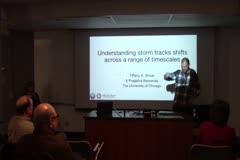
Understanding storm track shifts across a range of timescales
April 28, 2017
Tiffany Shaw
Hosted by Thomas Birner
Storm tracks are regions where extratropical cyclones occur most frequently, they control weather and climate in the extratropics. Storm tracks shift latitudinally in response to energetic perturbations across a range of timescales. On seasonal timescales, the Northern Hemisphere storm track shifts poleward between winter and summer and equatorward between summer and winter. On interannual…
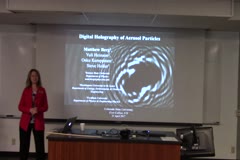
Digital Holography of Aerosol Particles
April 21, 2017
Matthew J. Berg
Hosted by Sonia Kreidenweis
Methods to determine the physical properties of aerosol particles is important in a vast array of scientific and applied contexts. Due in part to the difficulty of collecting such particles, a variety of contact-free techniques have been developed that infer information about the particles in an indirect manner. A popular example is elastic light-scattering where the angular pattern of light…
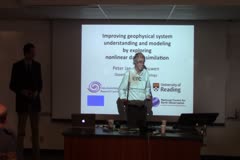
Improving geophysical system understanding and modelling by exploring nonlinear data assimilation
March 30, 2017
Peter Jan van Leeuwen, Visiting ATS from the University of Reading
Hosted by Chris Kummerow
Geophysical systems can be characterised as complex, nonlinear and high dimensional. All of these provide major challenges to understanding and modelling. To explore observations and existing knowledge encoded in numerical models to their full extent one can try to combine both sources of information. A systematic tool for doing this is data assimilation. It can be used to provide a description…
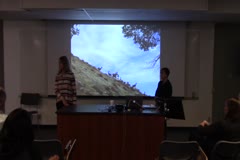
Measuring and interpreting faunal responses to climate in the Intermountain West
March 24, 2017
Erica Fleishman, CSU Professor, Department of Fish, Wildlife and Conservation Biology
Hosted by Sonia Kreidenweis
There is considerable research and management interest in whether and how native faunas are responding to climate change. Evaluating whether empirical data support range-shift hypotheses is complicated by variation in climate, differences in response variables and the extent and resolution of analyses, and mismatches between the resolutions at which climate data typically are available and…
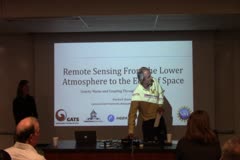
Remote Sensing of the Atmosphere from the Troposphere to the Edge of Space
March 09, 2017
Katrina Bossert
Hosted by Chris Kummerow
of the atmosphere considered the edge of space near ~80-100 km. For some aspects of the atmosphere, studying coupling between different altitudes and regions is important for a more in depth understanding. Gravity waves are one aspect integral to understanding atmospheric coupling, as they strongly influence dynamics within the atmosphere via the transport of energy and momentum from the lower…
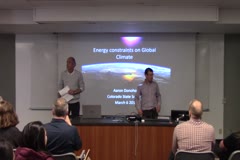
Energetic constraints on global climate
March 06, 2017
Aaron Donohoe
Hosted by Chris Kummerow
Spatial variations in the solar heating of the climate system drive the atmospheric and oceanic circulation and set patterns of temperature and precipitation. This presentation explores the processes that determine the absorption of solar radiation in the climate system including latitudinal, vertical and seasonal distributions. It is shown that atmospheric circulations and temperature adjust…

Using remote sensing observations to advance understanding of cloud-aerosol-precipitation-radiation interactions
March 02, 2017
Christine Chiu
Hosted by Chris Kummerow
Currently, the scientific community is unable to identify how characteristics of clouds will alter as the climate warms in response to emissions of greenhouse gases from human activities, and to what extent changes in cloud characteristics will feed back on surface temperature responses. In particular, models disagree substantially in the magnitude of cloud feedback for the regimes of…
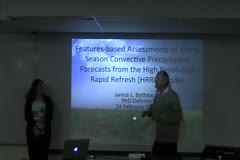
FEATURES BASED ASSESSMENTS OF WARM SEASON CONVECTIVE PRECIPITATION FORECASTS FROM THE HIGH RESOLUTION RAPID REFRESH MODEL
February 24, 2017
Janice Bytheway
Hosted by Chris Kummerow (advisor), Dave Randall, Russ Schumacher, Curtis Alexander (NOAA), Chandra Venkatachalam (Electrical and Computer Engineering)
Forecast models have seen vast improvements in recent years, via increased spatial and temporal resolution, rapid updating, assimilation of more observational data, and continued development and improvement of the representation of the atmosphere. One such model is the High Resolution Rapid Refresh (HRRR) model, a 3 km, hourly-updated, convection-allowing model that has been in development…
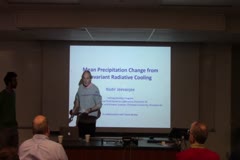
Mean precipitation change from invariant radiative cooling
February 23, 2017
Nadir Jeevanjee
Hosted by Chris Kummerow
Global warming simulations robustly show that mean precipitation increases at 1-3% per Kelvin, but we do not know what sets these values. Mean precipitation is constrained by radiative cooling, however, and we demonstrate here that radiative cooling profiles exhibit a certain invariance under warming when plotted in temperature coordinates. This invariance can then be leveraged to derive simple…
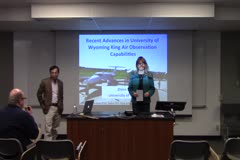
Recent Advances in University of Wyoming King Air Observation Capabilities
February 17, 2017
Zhien Wang
Hosted by Sue van den Heever
University of Wyoming King Air (UWKA) is a part of NSF-supported Lower Atmosphere Observing Facilities (LAOF). Through multi-year development efforts, UWKA has equipped with integrated observation capabilities for cloud dynamics and microphysics, aerosols, and environment conditions through combining lidar, radar, radiometer and in situ measurements. Approaches were developed to retrieve…

Recent Advances in University of Wyoming King Air Observation Capabilities
February 17, 2017
Zhien Wang
Hosted by Sue van den Heever
University of Wyoming King Air (UWKA) is a part of NSF-supported Lower Atmosphere Observing Facilities (LAOF). Through multi-year development efforts, UWKA has equipped with integrated observation capabilities for cloud dynamics and microphysics, aerosols, and environment conditions through combining lidar, radar, radiometer and in situ measurements. Approaches were developed to retrieve…
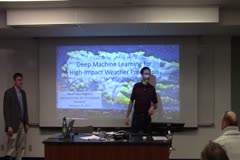
Deep Machine Learning for High-Impact Weather Forecasting
February 10, 2017
David John Gagne
Hosted by Greg Herman and Russ Schumacher
The weather forecasting process has grown more complex in recent years with the growing amount of observational data and model output available to weather forecasters and the trend toward providing more impact-based decision support services. In order to assist forecasters and end-users with the task of managing the firehose of data, I have developed and evaluated machine learning forecast…
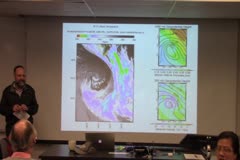
Seasonal Variability of Warm Boundary Layer Cloud and Precipitation Properties in the Southern Ocean as Diagnosed from A-Train and Ship-Based Remote Sensing Data
February 03, 2017
Jay Mace
Hosted by Paul DeMott
The extensive cloudiness and resulting high albedo of the Southern Oceans (SO) are predominantly due to the occurrence of widespread marine boundary layer (MBL) clouds. Recent work finds correlations between biogenically enhanced cloud condensation nuclei concentrations and cloud droplet number concentrations derived from passive satellite data. The active remote sensors in the A-Train have…
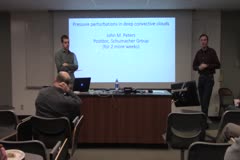
Pressure perturbations in cumulus convection
January 20, 2017
John Peters
Hosted by Russ Schumacher
Pressure perturbations are regions of anomalously low or high pressure in deep convection and play key roles in modulating the magnitude and distribution of vertical velocities within cumulus clouds. A cloud's vertical momentum budget is primarily regulated by two pressure forces: Effective buoyancy pressure acceleration (EBPA), and dynamic pressure acceleration (DPA). I will first discuss…
